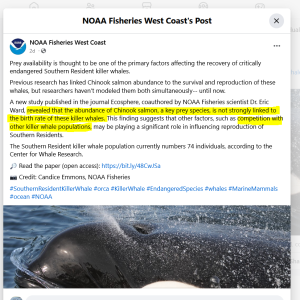SpringVelocity
Crew Member
Question 6: Do you have comments or considerations regarding the proposed Speed Restricted Areas (Green Hatched Areas in the map above) off the west coast of Vancouver Island around Swiftsure Bank?
Speed restrictions are needed for all vessels on Swiftsure Bank. Yet, we are concerned that the 10 knot speed limit for small vessels may still be too high, and does not reflect the most recent findings of vessel disturbance that shows foraging can be disrupted within 1 km of vessels. As such, lower speeds or vessel exclusions may be required to support foraging SRKW. Increased monitoring & surveillance of non-AIS vessels and their compliance with speed restrictions is needed.
Question 7: Do you have comments or considerations regarding the proposed salmon fishing closures (identified in blue in both maps above) off the West Coast of Vancouver Island around Swiftsure Bank?
Successful feeding from spring to fall is important to the survival and recovery of Southern Residents. As such, Option 2 is the preferred scenario for SRKWs as it provides a greater opportunity for whales to feed with minimal competition from fishing, disturbance and noise from vessels in the important foraging area near the mouth of Port Renfrew
Question 7: Do you have comments or considerations regarding the proposed salmon fishing closures (identified in blue in both maps above) off the West Coast of Vancouver Island around Swiftsure Bank?
Successful feeding from spring to fall is important to the survival and recovery of Southern Residents. As such, Option 2 is the preferred scenario for SRKWs as it provides a greater opportunity for whales to feed with minimal competition from fishing, disturbance and noise from vessels in the important foraging area near the mouth of Port Renfrew
Question 8: Do you have comments or considerations regarding the proposed approach distance and/or the impeding the path prohibition?
The 400m vessel approach distance is not in alignment with the best available science, which shows negative effects of vessel noise and disturbance on foraging within 1000m. Increasing the buffer to 1000m for all killer whales is necessary to further reduce foraging impacts and will harmonize Canadian regulations with upcoming changes in US waters.
Question 9: Do you have comments or considerations regarding the continuation of these voluntary measures?
These voluntary measures are supported, however, the extent of compliance and their effectiveness needs to be assessed. In previous years, there has been no surveillance or reporting on the extent of compliance by government. An assessment of the numbers of boaters who participate and their overall effectiveness is required.
Question 10: Do you have any comments you would like to share with the Government of Canada regarding the transition from interim management measures to long-term protections?
Yes. Effective, long term recovery measures are needed. The seasonal actions identified here need to be a broader set of comprehensive threat reduction measures on a scale biologically meaningful for SRKW survival and recovery. This includes robust measures for prey, noise and contaminants such as moving west coast Chinook interception fisheries, noise reduction targets in the Salish Sea that are meaningful for whales, and taking action to reduce contaminants in SRKW critical habitat and prey.


